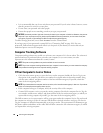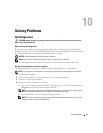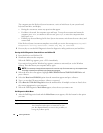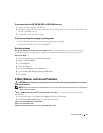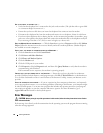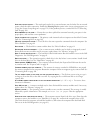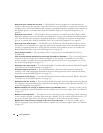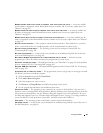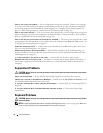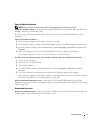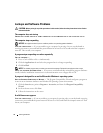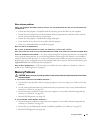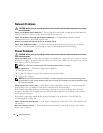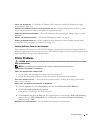
68 Solving Problems
HARD-DISK DRIVE CONTROLLER FAILURE 0—The hard drive does not respond to commands from the
computer. Shut down the computer, remove the hard drive (see "Hard Drive" on page 90), and boot the
computer from a CD. Then shut down the computer, reinstall the hard drive, and restart the computer. If
the problem persists, try another drive. Run the Hard-Disk Drive tests in the Dell Diagnostics (see
page 61).
HARD-DISK DRIVE FAILURE — The hard drive does not respond to commands from the computer. Shut
down the computer, remove the hard drive (see "Hard Drive" on page 90), and boot the computer from a
CD. Then shut down the computer, reinstall the hard drive, and restart the computer. If the problem
persists, try another drive. Run the Hard-Disk Drive tests in the Dell Diagnostics (see page 61).
HARD-DISK DRIVE READ FAILURE — The hard drive may be defective. Shut down the computer, remove
the hard drive (see "Hard Drive" on page 90), and boot the computer from a CD. Then shut down the
computer, reinstall the hard drive, and restart the computer. If the problem persists, try another drive.
Run the Hard-Disk Drive tests in the Dell Diagnostics (see page 61).
INSERT BOOTABLE MEDIA — The operating system is trying to boot to a nonbootable CD. Insert a
bootable CD.
INVALID CONFIGURATION INFORMATION-PLEASE RUN SYSTEM SETUP PROGRAM — The system configuration
information does not match the hardware configuration. The message is most likely to occur after a
memory module is installed. Correct the appropriate options in the system setup program (see "Using
the System Setup Program" on page 139).
KEYBOARD CLOCK LINE FAILURE — For external keyboards, check the cable connection. Run the Keyboard
Controller test in the Dell Diagnostics (see page 61).
KEYBOARD CONTROLLER FAILURE — For external keyboards, check the cable connection. Restart the
computer, and avoid touching the keyboard or the mouse during the boot routine. Run the Keyboard
Controller test in the Dell Diagnostics (see page 61).
KEYBOARD DATA LINE FAILURE — For external keyboards, check the cable connection. Run the Keyboard
Controller test in the Dell Diagnostics (see page 61).
KEYBOARD STUCK KEY FAILURE — For external keyboards or keypads, check the cable connection. Restart
the computer, and avoid touching the keyboard or keys during the boot routine. Run the Stuck Key test
in the Dell Diagnostics (see page 61).
MEMORY ADDRESS LINE FAILURE AT ADDRESS, READ VALUE EXPECTING VALUE — A memory module may be
faulty or improperly seated. Reinstall the memory modules and, if necessary, replace them (see "Memory"
on page 92).
MEMORY ALLOCATION ERROR — The software you are attempting to run is conflicting with the operating
system, another program, or a utility. Shut down the computer, wait 30 seconds, and then restart it. Try
to run the program again. If the error message still appears, see the software documentation.
MEMORY DATA LINE FAILURE AT ADDRESS, READ VALUE EXPECTING VALUE — A memory module may be
faulty or improperly seated. Reinstall the memory modules and, if necessary, replace them (see "Memory"
on page 92).



